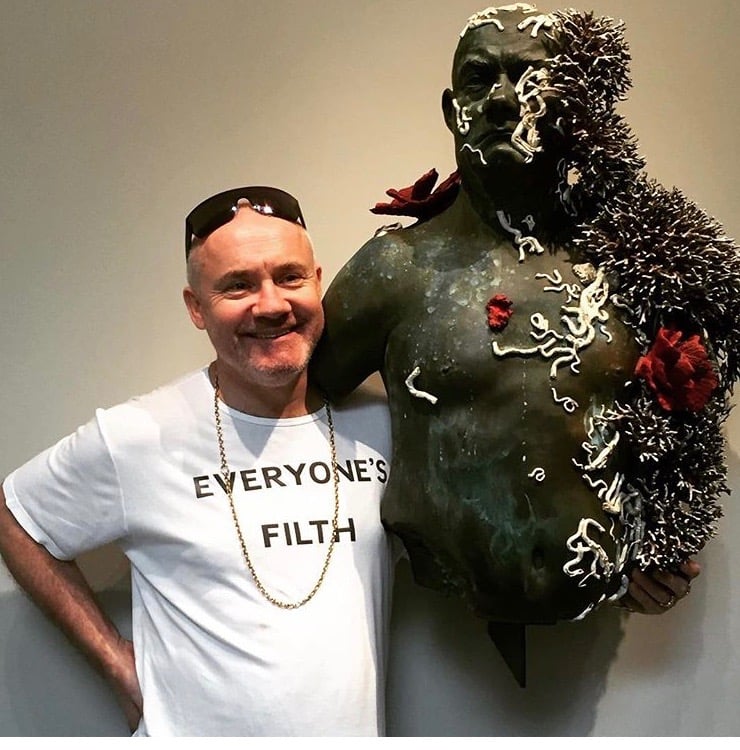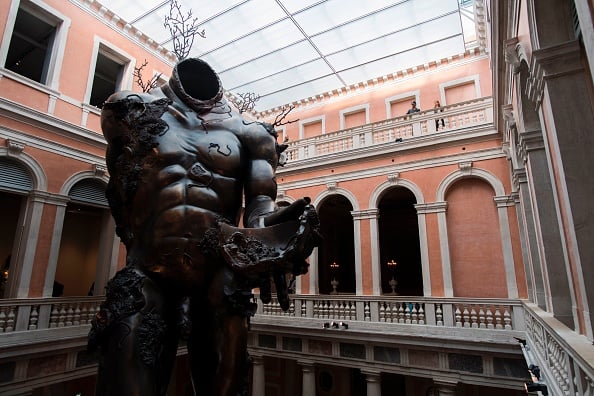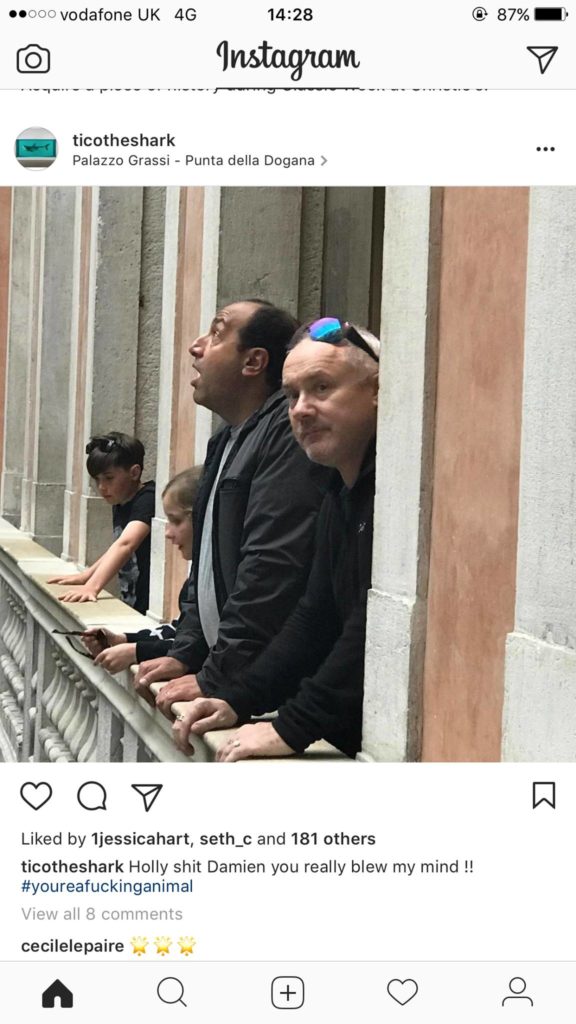Art World
Is This Show Worth a Billion Dollars? A Few Thoughts on Damien Hirst’s New Venture in Venice
Our itinerant dealer-scribe stops by Venice to drink in Damien Hirst's subaqueous art extravaganza.

Our itinerant dealer-scribe stops by Venice to drink in Damien Hirst's subaqueous art extravaganza.

Kenny Schachter

Buckets of (digital) ink have already been spilled on the subject, but I’ll add more. I have pretty much seen every artwork that Damien Hirst has made, read his book On the Way to Work (written with Gordon Burn in 2001), and sat through both Sotheby’s auctions he staged in 2004 and 2008. I’ve bought, sold, curated, and continue to own his pieces. Hirst game-changed history with his early spot paintings referencing pills and his vitrine and cabinet still lifes. At my age, you readily relate to (and can find beauty in) the concept and appearances of medication.
I’ve often smiled at the witticisms of his words and titles too, from the shark (version one-of-many) to the skeleton seeming to float on a glass cross with bobbing ping-pong ball eyes titled Rehab Is for Quitters (1998-99). Drugs, booze and death, religion and redemption—he hit them all, hard. His successes were awe-inspiring and part of the program since its inception. You can’t manufacture the degree of accomplishments and brilliance of his early works from the late 1980s to the mid-’90s, which, for better or worse, spawned his latest project, “Treasures From the Wreck of the Unbelievable,” at François Pinault’s palaces in Venice. You won’t find much humble pie on the menu there.

Damien Hirst’s Demon With Bowl at “Treasures From the Wreck of the Unbelievable” at the Pinault Collection in Venice. Miguel Medina/AFP/Getty Images.
I also read Hirst’s essay, Why Cunts Sell Shit to Fools, first published in Idler magazine and republished in the catalogue for the 2004 Tate Britain exhibition “In-A-Gadda-Da-Vida.” In the essay, he denounced the disingenuous (in any sector) who insincerely sell crap to the unsuspecting. Why? Because they can. I fear Hirst has now fallen into the same trap without so much as taking notice. But I just had to see the spectacle for myself.
With this latest endeavor, Hirst wants viewers to achieve a state of suspended disbelief—like a parent placing a trace of cotton by the fireplace beside a plate of half-eaten cookies on Christmas morning, providing Santa “proof” for their gullible child. I don’t buy into it whole cloth or (entirely) in fragments. I understand the appeal of Walt Disney (who may or may not have been a rabid racist), Duchamp’s Readymades, and the notion of Koonsian Had-It-Mades, but this is beyond.
Throwing the kitchen sink at the foundry without waiting to see what sticks (and what stinks) is fabrication off the hook, sans editor. The enterprise smacks of the Atlantis casino in Paradise Island in the Bahamas, or Sexy Fish, the ill-conceived title of the high-end restaurant in London that Hirst decorated in 2015. Think Big—the 1988 Tom Hanks film, that is—but bigger. Imagine Jeff Koons with a Brit accent. Of course, CNN was on hand for full coverage of the opening.
A lot (not all) of the work had the whiff of expensive props in a comedy show called “Art.” (“Made in China” was cheekily stamped on the back of a forgettable bronze thing.) The humor is juvenile, and I bet the sheer size and displacement of space has had negative implications for global warming—and made Julian Schnabel jealous in the process.
My personal favorite, not that anyone should care, is the sculpture of Hirst himself as degraded nautical ship figurehead. Although I’d like it better if the head turned furtively from side to side, and then blurted out in a throaty, smoker’s voice, “Hey fool, fool! Yeah you. You wanna buy some shit? C’mon, you fool!” Granted, I sound like the art-world version of insult comic Don Rickles (RIP).
The socialist-leaning UK Evening Standard critic Matthew Collings inconceivably bought in, stating that the colossal collection of works would be better served if they remained intact. We argued about it for three days after on Facebook (the joy). You couldn’t fathom a more nightmarish version of the Remain referendum, but I’ll concede this much: the works could stay together on a far-off planet or a disused barge cut loose to float unchartered at sea. Whether illusion or delusion, at the least it’s an unprecedented (in scale and cost), blockbusting period piece, set in the garish here and now.
Regarding the well-publicized production total, said to be £50 million: I watched the original BBC footage of the first interview about the project (OK, I sound borderline fanatical) and Hirst actually stated the figure was between £50 million and £100 million! This boggles the mind and logic—and would equate to an awful lot of mouths fed—but that’s academic and sour-grapes-sounding. Damien’s self-belief is unflinching. He’s invested somewhere around $100 million of his own money and that of his investors—said to include Pinault and the Fertitta brothers, of Ultimate Fighting Championship fame and fortune (to the tune of $30m, according to my friend Deep Pockets)—into himself.
But the potential ROI (return on investment) it is enough to make a hedgie hard. The New York Times reported that prices for the new work range from $500,000 to upwards of $5 million. And everything on view is in an edition of three—one in each of three different “states”, or materials—plus two artist proofs (for a total of five). So, if each of the 189 works in the show sells for an average of $1 million apiece, the potential return is nearly $1 billion. Even the book comes in three versions. Genius.
But let’s say the show is selling as well as some dealers contend—it will still be a long time before Hirst gets above the high-water mark (the level of initial expenditure). Once the works begin to go to auction—which will be soon, if the recent past is any indication—then it won’t be long before we see what the market genuinely thinks. Based on the sheer amount of stuff, it looks like a whole lot of day-sale lots.
So far, the public feedback has been overwhelmingly positive, from the (hagiographic) Financial Times and New York Times profiles to Tico Mugrabi’s backslapping Instagram post depicting Mugrabi (mouth agape) and Damien (distractedly) on a balcony in Venice peering into the horizon with the caption, “Holy shit Damien you really blew my mind!! #youreafuckinganimal.” Well said.

Tico Mugrabi’s Instagram post. Courtesy of Kenny Schachter.
Anyway, to each their own in effectuating their dreams and having the wherewithal to pull off something of this scale. At the least, Damien has given us something to see and (endlessly) talk about. But that doesn’t make it morally sound—not only in today’s world (which is dire), but in any world. That to me is the rub. If Bruce Nauman or Robert Gober, two great artists with a fraction of Hirst’s audience (and cash), had access to the world’s resources, they wouldn’t disabuse it and over-produce in so frivolously ginormous and opulent a fashion. Forget Koons—he’d surely shoot the wad in the blink of an eye.
Hirst’s unbridled naked ambition is the most notable takeaway, selfish and solipsistic, reflecting a little of us all. Yes, I am complicit, materialistic, etc., but I couldn’t produce something akin myself—and wouldn’t even if I could afford to. I don’t buy into a critical element of the project either. You can’t have your cake and eat it, 15 times each slice, multiplied by eternity. Besides, Banksy did Disney better in “Dismaland.” And he did it for peanuts.
The t-shirt Hirst sported at the opening read, “Everyone’s Filth.” If this extravaganza makes anything clear, it’s that, indeed, we are. Wikipedia calls Damien an “artist, collector, and entrepreneur”; the show co-mingles all three. I’d add, with a smile, “diamond-encrusted, gold-plated whore.”
NEXT UP: Meanwhile, in Brussels…
All videos courtesy of Kenny Schachter.